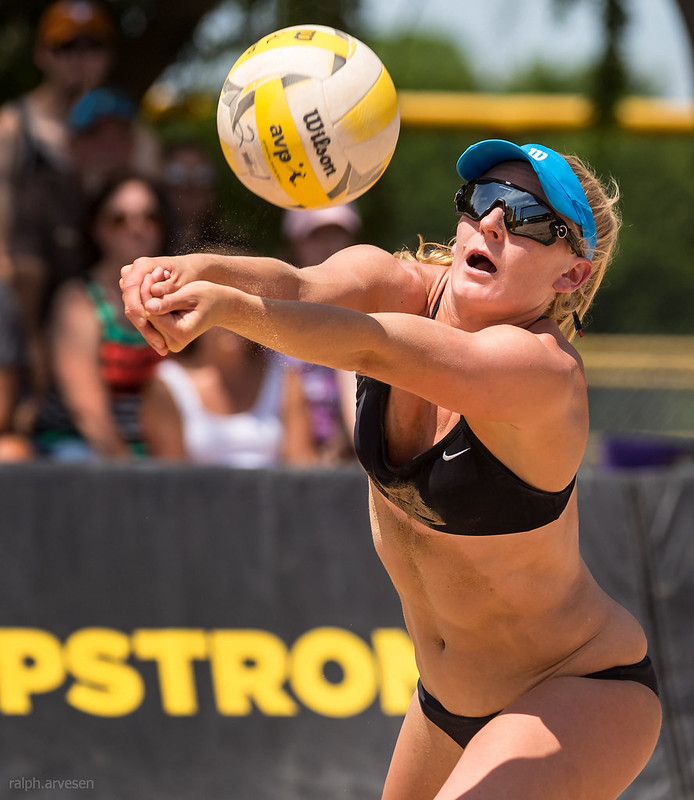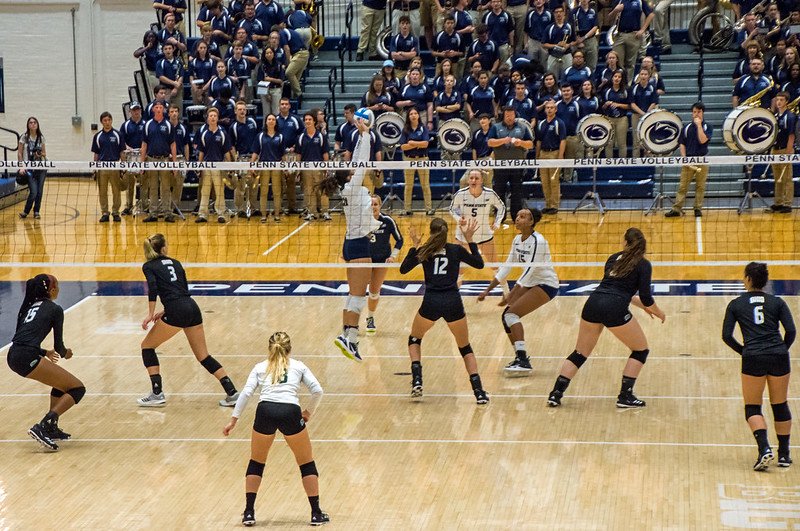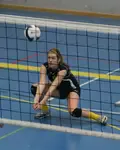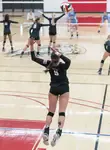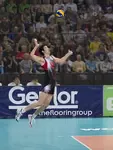- Improve Your Volleyball with Coach April
- Volleyball Techniques Fix Your Pass, Set, Serve,
- What is a volleyball dig?
What Is A Volleyball Dig And When Is It Done During Defensive Plays?
What is a volleyball dig? Its the way to keep the ball off the floor on defense when the opposing team hits a hard driven or softly contacted attacked hit.
A dig is a fundamental defensive skill in volleyball that is an important part of
- defending your court,
- keeping an attacked ball off the floor of your court so your team can replay it and
run an attack in an effort to score a point.
When you master the volleyball dig, you become an integral part of your team's defense, because you'd be preventing the opposing team from scoring points and keeping the rally alive so your team can run their offense.
In this article, I provide a comprehensive guide on how to execute a volleyball dig with proper body positioning, arm placement, and technique, as well as share tips and strategies for a successful dig.
A Step-by-Step Guide to Perform a Volleyball Dig
1. Positioning:
While you're in the back row, position yourself just outside of the block where the opposing team's setter has set their hitter, and this should be where the ball is most likely to be hit.
 What is a volleyball dig? While you're in the back row, position yourself just outside of the block where the opposing team's setter has set their hitter, and this should be where the ball is most likely to be hit. (Shots by Shanty)
What is a volleyball dig? While you're in the back row, position yourself just outside of the block where the opposing team's setter has set their hitter, and this should be where the ball is most likely to be hit. (Shots by Shanty)2. Stance:
Be in an athletic stance with your feet shoulder-width apart. Bend your knees slightly, keeping your weight centered and on the balls of your feet.
Keep shoulders slightly in front of knees.
This provides stability and enables quick reactions.
How to Dig in Volleyball:
To dig a volleyball up in defense you keep an attacked ball by the opposing team off your court floor by extending your arms and hands under the ball to deflect it back in the air before it hits the floor.
3. Arm Placement:
Extend your arms in front of you at about belly button level with your palms facing up and your fingers spread apart.
Keep a slight bend in your elbows, which will allow for better control and absorption of the ball's impact.
4. Read the Attacker's Movements
Ball - Setter - Ball - Hitter
BALL
Watch the trajectory and speed of the ball that is passed from the passer to the setter.
SETTER
If its a bad pass then the setter has to move off the net to go get under the ball to set it.
Watch the setter to see what type of ball they are going to set and who they are going to give it to.
BALL
Watch the ball and how high or how low and how fast the set is and where its going to drop along the net.
HITTER
Then watch the hitter. Now that the ball is about to contacted by the hitter...watch the hitter's arm and place yourself in the patch of the ball which you can now see because you're standing just outside of your blockers waiting for the hitter to hit the ball right at you.
This will help you react more efficiently and position yourself to make a successful dig.
5. Timing:
After the ball has been hit, time your movement by tracking its path and drop your hips so you lower your body is closer to the floor so when digging the ball the trajectory of the ball goes up in the air while staying on your side.
How do you place your arms and hands together to form a digging platform when contacting the ball?

Both arms are usually held together at the wrists so your arms form a flat surface, called a "platform" for the ball to bounce off of.
This technique involves contacting and intercepting the ball before it hits the ground utilizing your forearms to keep the ball in play.
6. Contact:
The goal is to deflect the ball in an upward trajectory, allowing your teammates to continue the play.
4 Digging Drills For Volleyball Players To Do Like This Hit And Dig Drill With Cross Court Digging
Remember there are two ways to do this drill.
In this version we set the ball baskets as targets where the setter's would be. There are actually two digger groups working one in the left back Zone 5 position and one with a right back Zone 1 defensive position.
Hitters alternate at a steady rhythm so the drill moves quickly and diggers have a brief pause to recuperate after each dig.
7. Freeze your platform:
After making contact with the ball, freeze your platform arms together with shoulders angled to your target so this keeps the ball in the air longer.
Tips for a Successful Volleyball Dig
1. Focus on Your Platform:
The area between your wrists and elbows is known as your platform. Keep your platform firm and rigid to cushion the impact of the ball and minimize the chances of shanking the ball.
2. Be Aggressive and Stay Relaxed:
While you need to be ready and alert, avoid tensing up too much. Keep your upper body relaxed to avoid excessive tension which can prevent you from controlling the ball.
3. Move with Agility:
Shuffle steps are your friend. Fast shuffe steps will help you move your feet laterally to adjust yourself to get in front of the attacker's hit, and be prepared to move forward or backward to react to a ball that isnt hit right at you.
4. Communicate with Your Team:
Effective communication is crucial in volleyball. Maintain constant communication with your teammates to ensure proper coverage so the teammates on your right and left are all on the same page ...
Remember, practice and repetition are essential for mastering this skill.
So get out on the court, improve your defensive play, and contribute to your team's success.
To dig a volleyball means you contact and intercept the ball, while your team is on defense by deflecting it up in the air with your arms held together.
You defend, or dig the volleyball once it crosses into your court after an attack hit by the opposing team, so they don't score a point.
A Dig Is The Last Line of Defense For A Team
What is a volleyball dig?
The team on defense has three blockers in the front row who will try and stop the opposing team's attack hit at the net by blocking the ball before it comes over the net.
If the blockers can't block it then the three players on defense in the back row, also called 'diggers' or 'defensive volleyball players', will use their defensive volleyball skills to dig the ball up to keep it off the ground so the opposing team can't score a point.
On defensive plays, the block is the first line of defense for a team and the dig is the second and last line of defense for a team to try and keep an opposing team's attack hits from scoring points by keep the ball off the floor.
When your team blocks, you are defending your court at the net, and if the ball gets by the block, then your back row players. also known as 'diggers', defend your court by digging the ball up into the air so it doesn't hit the floor.
The minute your team digs a volleyball up and the ball stays on your side your team changes or "transitions" from being a team on defense to becoming a team on offense.
What is A Dig?
You defend, or dig the volleyball once it crosses into your court after an attack hit by the opposing team, so they don't score a point.
Your team keeps the opposing team's attack off your floor, but you've also set your team up to run an offensive attack sending the ball into the opposing team's court.
Now its their turn to try and block your team or make a defensive volleyball play or dig a ball up that you or your attackers send into their court to try and score a point.
Do You Follow Me on Pinterest?
Follow me on Pinterest Volleybragswag to improve your game even faster!
I share alot of individual, partner and easy-to-do volleyball serving drills we do in class with my followers.
Many of these volleyball practice drills you can do at home by yourself or try at your next practice with your teammates.
If you're a B team or JV player trying to make varsity next year...your goal should be to complete 1000 reps a day of at least three of the basic skills on your own...volleyball passing, serving and setting should be at the top of the list.
What Is A Volleyball Dig?:
Where Do You Go Now?
Okay here's where you need to go now! There are three options:
- Learn more about Digging and Defense by clicking the Related Links below. .
- Follow the suggested reading on our Sitemap page Learning How To Play (Sitemap)
- Or visit the pages in the How to Play Volleyball section in the drop down menu at the top of the page to get started.
- Before leaving this page Say "Hi" to Miss O.I Gotchu the Octopus wearing the #8 jersey below. Miss O.I. is the libero for the All Beast VolleyBragSwag All Star team.
If your athlete struggles with consistent serve receive, gets subbed out, or is overlooked for playing time—this is the fix you’ve been looking for.

Struggling with passing consistency?
I help talented passers tired of getting pulled from games because of inconsistent serve receive skills BUILD passing confidence without expensive private lessons using the same 3-step system that's helped dozens of my athletes get recruited.
Download my eBook for $17.99 and start building the passing confidence that keeps you on the court—and gets you seen by college coaches.
From Lady Vol to Legend: Coach April Produces Powerful Passionate Players...is that you?
What Are You Looking For?
Click to Download Your Pre Serving Ritual Mastery Checklist pdf:
🎯Volleyball Pre Serving Ritual Guide -
Players! Learn How To Transform Your Serve from Weak to Weapon
Click to Download Your Parent's Volleyball Serving Checklist pdf
🎯Parent's Volleyball Serving Checklist Guide
Parents! Help Your Player Develop Championship Serves (Even If You've Never Played)

Hi there!
Thanks for stopping by. Hope you learned something today that will help you reach your volleyball goals.
Be sure to subscribe to my email newsletter so you can learn more each week!
Stay strong! Stay motivated!
-Coach April

SUSCRIBE to my email newsletter below!
 Click to learn more about the weekly volleyball classes and clinics or email info@imrpoveyourvolley.com for information
Click to learn more about the weekly volleyball classes and clinics or email info@imrpoveyourvolley.com for informationCongratulations to my seven Boys-18s Vegas Volley club players who played in two state championship finals yesterday, the 3A and 5A State champinship finals at Sunrise Mountain High School.
TOURNAMENT CHAMPIONS!
A-1 Vegas Volley VBC
In It To Win It Tournament
May 2 - 4, 2025 Tournament
Gold Medalists
18s Premier Division
Vegas Volleyball's Unsung Heroes: Celebrating Moms with Peace Love Volleyball Shirts
Ready to energize your volleyball mom journey?
Subscribe to my 'Producing Powerful Passionate Peaceful Players' email list above on ImproveYourVolley.com.
You'll receive energy-boosting tips, exclusive insights from me, Coach April Chapple on maintaining momentum in volleyball.
Let's power up the Vegas volleyball scene together!
Recent Articles
-
Use A Jump Float Serve To Create Power For An Ace Or To Start A Rally
Dec 31, 25 09:31 PM
Use the overhand jump float serve to generate a powerful serve that starts a rally after the ref blows the whistle for the player behind the service line. -
Types of Volleyball Serves What's A Float, Jump Float, Spin, Jump Spin
Dec 31, 25 09:13 PM
What're the types of volleyball serves like the standing float serve, the jump float where you add spike approach footwork and the topspin and jump spin serves. -
Overhand Jump Serve Volleyball Tips To Score Many More Points and Aces
Dec 31, 25 09:09 PM
My "Coach April Overhand Jump Serve Volleyball Tips" designed to help you increase your serving accuracy, power and the ability to serve more aces in volleyball.

